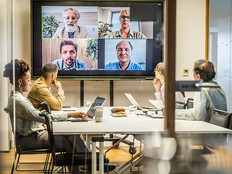Like local governments across the United States, Montgomery County, Pa., rapidly ramped up tech support earlier this year for employees who were forced to work from home due to the pandemic. Simultaneously, the county pivoted to increase digital services for citizens who depend on access to government assistance.
Through this transition, Montgomery County CIO Anthony Olivieri capitalized on his agency’s early investment in virtual infrastructure and cloud computing. Olivieri chatted with StateTech Managing about how his county supported employees working from home while also supporting citizen services — in part with help from CDW.
STATETECH: What technology challenges did the county face at the onset of the pandemic?
OLIVIERI: We faced a host of questions: What level of our business continuance plan are we going to enact? What do we need to get ready for? If people need to work from home, are we going to be able to facilitate requests from officials and citizens? We took a very hard look at our VMware virtual desktop environment, which we knew was ready for prime time. We looked at our VPN solution as a backup to that, and we made sure we had very good inventory control in place for equipment that was going to leave the county.
We made sure we had sufficient training material, so we could put it in the hands of our users, whether as a physical copy or through our SharePoint portal. In Montgomery County, we were a virus epicenter very early on, so things were unfolding quickly.
And we rose to the challenge, I’m proud to say. My team rose to the challenge, and we were able to accommodate everyone. But also, partners like CDW came through for us, and CDW, make no mistake, came through for us on more than one occasion through this crisis. We threw everything at CDW, and they helped us out with laptops, webcams, monitors — whatever we required to support working from home.
READ MORE: Find out how state governments have addressed legacy IT in a time of crisis.
STATETECH: What technologies have helped you respond to the public and provide government services during the pandemic?
OLIVIERI: There are a couple of things that we did, but the cornerstone would be our enterprise architecture agreement through Microsoft, which CDW helps us navigate. So we’re trying to exercise our EA agreement as much as we possibly can. We are leaning on SharePoint heavily to keep people informed and to help businesses work with the county. We empower our users through the available information and systems, whether it’s through SharePoint or Dynamics, which enable processes that work for our constituents. Right now, a lot of the attention is on health and human services, as you can imagine, because we’re trying to conduct contact tracing and support clinics.
So the applications that we’re using were all through the Dynamics platform. It’s been very successful. People have embraced it. It’s easy to use, and we are having a lot of success with it at this point.
STATETECH: So, the county had immediate needs, but I understand that, after a few months, you faced new requirements. What challenges emerged over time?
OLIVIERI: When something like this happens, your risk level for any kind of breach or threat goes up exponentially. So, we have been working with Microsoft to put in additional security features. We’re continually striving to enhance our cybersecurity posture to protect our users and to protect our data infrastructure. At the end of the day, our goal is to protect our constituents’ data.
So if our users are sitting at home and they’re already under the gun, stressed out about COVID and how they’re going to work in this new environment, many of them are not thinking about security. They’re just trying to process their work. They want to make sure that everybody knows that they’re working, and they’re doing what they can. They’re caught up in this hustle and bustle. The next thing you know, they click on something they shouldn’t, and we get a phone call. It’s human nature.
We have been trying to strengthen network security, but specifically in such a way that it will continue to enable and help our users who are working remotely to be productive without locking them down so tight that they can’t do anything.
MORE FROM STATETECH: Find out how to protect remote workers from phishing attacks.
STATETECH: Could you provide some perspective on your investments in cloud computing, and how the county was positioned via the cloud?
OLIVIERI: We were already positioned very well through our enterprise architecture. We have a Microsoft Azure commitment that is the right size for us. So, we were able to spin up infrastructure that we needed in no time at all, and ready-to-go infrastructure for our developers immediately. Once they had done their part and put everything in place, we were able to rapidly deliver it to our users.
So, we’re very happy. We’ve been Azure customers now for maybe eight years. And every year that goes by, we put more resources in Azure when it makes sense.
I’m not an “all cloud” CIO. I think you need the right tool for the job. So, we evaluate everything that comes our way. The first question we do ask is, is this something that could run on Azure? And if it can, what’s it going to look like in Azure? How much additional horsepower, if any, are we going to need to put in there? Are there any special considerations?
Most important, how much will it cost to run something like this in Azure? That’s a big consideration because it has to make financial sense. You could just do it because it’s the latest technology and everybody thinks that’s just the way to go, and it’s going to give you some level of protection that you don’t have in a traditional data center. But that can lead to a false sense of security. There are there still things you have to do to optimize your cloud-based infrastructure, to keep it running as expected and to ensure it’s cost effective.
STATETECH: Is there anything important to you that we haven’t yet highlighted?
OLIVIERI: Like most technologists, I can sit around a table and talk about technology all day — what you’re doing, why you’re doing it and how you did it. If you get five technologists in a room sitting around a table, you’re going to get 20 different answers to any question.
Here’s what’s really important to me. You can have all of the technology you can handle, and you can have the blessings of your commissioners, which we do here in Montgomery County — but the unsung hero is the IT professional.
If you think about the demands that have been put on IT across the board — I don’t care where they are or what they’re doing — if you think about the demands that have been put on the IT professional during COVID, I don’t think anyone would deny that you’ve got nothing without technology. Imagine if COVID hit to a point where your IT professional couldn’t help you, couldn’t reboot your router, even if it was a core router somewhere out on the internet. And things started to degrade. I’ve seen my team in action. I’ve had individuals get sick. I’ve had people with family members getting sick. I’ve had people just completely freaked out about COVID and unable to function. And every single one of my people who were not affected remained without hesitation and got the job done.
I’ve worked through Y2K. I’ve worked through a host of storms. I’ve worked through 9/11, and I’ve never had anything even come close to this crisis — the anxiety, the amount of work that needs to be done and everything else.
It’s important for everyone to just take a second and think about that. There are so many dedicated IT professionals who did not hesitate. They rose to the challenge, like the champs that they are, everywhere.










